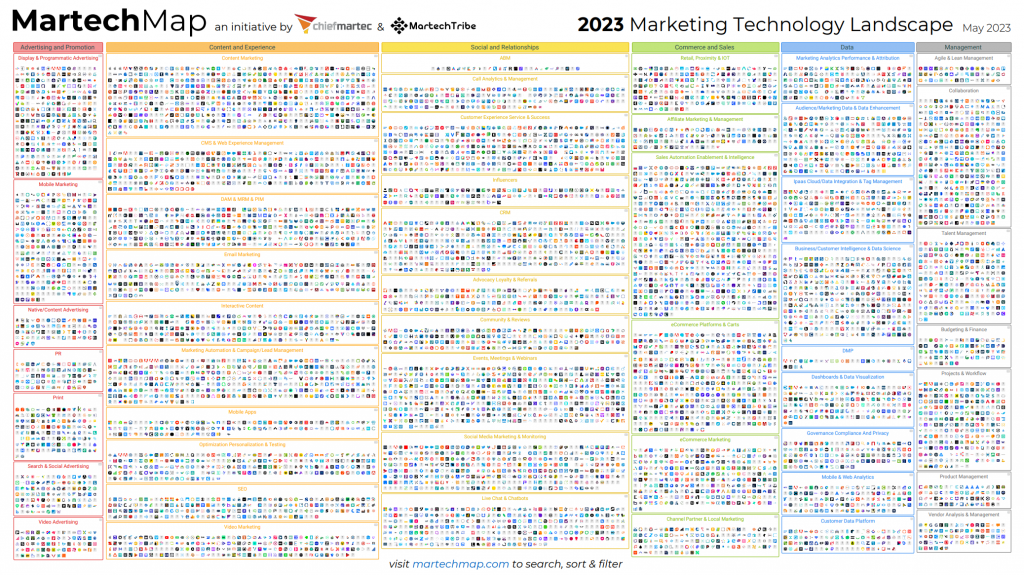There has been so much news about Dynamics 365 Customer Insights and MarTech in general in recent months that I find it super difficult to keep track of it all. My LinkedIn is full of Microsoft Copilot, tips on the best prompts, AI certifications from colleagues, which companies have already implemented AI use cases and so on. Every time I reload the feed, there are probably 10 new posts and 90% have to do with AI. The world of marketing is also in the thick of it. AI is already having a significant impact on marketing work.
That’s why I’m officially announcing the first MarTech March.
Ok ok, I don’t know if there’s been one before, but if there has, at least it’s the first one on my blog. In this series, I want to bridge the gap between theory and practice to navigate the ever-changing MarTech landscape – not without a focus on Dynamics 365 Customer Insights and the PowerPlatform, of course. I’ll take a look at the existing Copilot features, enhancement options with the AI Builder, experiment with Typeface and Prompt Engineering for Marketing and look at how AI can be introduced. Let’s start with the basics.
What is MarTech?
Unsurprisingly, MarTech is a combination of marketing and technology. In summary, it refers to everything that comprises digital tools, platforms and technologies that support marketing.
Anyone familiar with Moore’s Law will know that it states that the number of transistors on an integrated circuit doubles approximately every two years. In simple terms, this means that computer chips are becoming more and more powerful, i.e. their performance is increasing exponentially. This can also be applied to MarTech. Every year, Chiefmartec publishes a marketing map (Link) that covers all MarTech applications. The first report came out in 2011 with around 150 applications. In 2022 there were almost 10,000 and in November 2023 there were already 13,080. In the last six months before November 2023 alone, there was growth of more than 18%. All thanks in part to numerous AI start-ups.

In the future, MarTech will play an increasingly important role as companies focus more on data-driven approaches and personalized interactions with their target groups. More and more data is available, which in turn requires better technologies to make even better data-driven marketing decisions. And with MarTech, it is not only possible to address target groups more precisely, but also to adapt more quickly to the changing digitalized world. The integration of MarTech will therefore be crucial to how companies successfully interact with their customers and achieve their marketing goals in the future.
What is a MarTech Stack?
Think of a MarTech stack as a digital marketing toolbox. It’s a collection of software, tools and technologies that work in harmony to seamlessly implement marketing strategies. From email marketing and analytics tools to social media management and customer relationship management systems. The selection and integration of these technologies depends on the specific goals and needs of the organization. Chiefmartec categorizes marketing applications into six themes:
- Advertising & Promotion: This area focuses on technologies that support the planning, execution and optimization of advertising campaigns. The aim here is to increase the visibility of products or services. Example: Microsoft Advertising, Xandr
- Content & Experience: This category refers to the creation, management and optimization of content to enable interaction with customers, e.g. in email marketing, marketing automation, DAM, CMS. Example: Dynamics 365 Customer Insights Journey
- Social & Relationships: This area is all about managing and analyzing social interactions and building and maintaining customer relationships across different channels. Example: Hootsuite, LinkedIn, Dynamics 365 (as CRM), Microsoft Teams, chatbots
- Commerce & Sales: This is about technologies that support the sales process, from e-commerce platforms to sales automation and customer loyalty systems. Example: Dynamics 365 Sales, Dynamics 365 Commerce
- Data: This category includes technologies that enable data collection, analysis and processing for marketing purposes, including customer behavior, analytics and business intelligence. Example: PowerBI, Dynamics 365 Customer Insights Data, Microsoft Clarity
- Management: These are platforms that enable the coordination, monitoring and optimization of marketing activities, including project management, budgeting and team collaboration. Example: Sharepoint, Yammer, Azure DevOps
The world keeps turning, technologies are changing and customers have different requirements. To keep pace with the market, it is important for companies to continuously develop their MarTech stack.
MarTech and AI
Artificial intelligence is a much-discussed topic in the martech community. But AI is not just another application in the MarTech stack as mentioned above. Rather, it is a process that is used by many martech applications, just as Copilot is integrated into Customer Insights. In the context of Martech, AI is used to power applications that create text and image content, personalize messages, recommend next best actions, perform sentiment analysis, tag digital assets, create code – I could go on and on with the list.
Develop a MarTech strategy
Marketing departments face competitive pressure to be both more efficient and more innovative. In the martech industry, there is a paradoxical balance between financial efficiency and disruptive innovation. On the one hand, companies are looking to consolidate the stack to optimize costs. While at the same time investments in new technologies are necessary due to AI and changing customer behavior. The Gartner Marketing Technology Survey 2023 found that the majority of large marketing organizations are only using 33% of their existing capacity. This marks a significant decrease from 42% in 2022 and 58% in 2020. This also means that there is a lot of potential but it is not being used or not being used properly. Therefore, as always, a strategy is needed to counteract this trend (according to Gartner).

Four steps to more ROI
First, the existing MarTech stack should be reviewed, as unused technologies can be optimized or eliminated if necessary. For example, the applications used can be visualized using a kind of mind map to identify superfluous ones.
Improving the partnership between IT and marketing is the second crucial step. Collaboration can be improved by setting common goals, clear communication, shared tools, agile methods, data management guidelines, training and joint budgeting. A common understanding, open communication and the integration of technology promote efficiency, innovation and the success of the company.
Preparation for emerging technologies is the third key measure. Investing in talent, developing the skills of MarTech teams can be used as an advantage for innovations such as GenAI. Constantly introducing new, innovative tools only helps if employees are appropriately empowered.
Only in the last step should the potential of GenAI be examined more closely. Even if you quickly become enthusiastic about the new possibilities, you should approach the topic with caution. Clear use cases, technical dependencies and concepts can minimize risks.
Summary
The challenge is therefore to develop a balanced MarTech strategy that integrates both proven technologies and innovative AI applications. Dynamics 365 Customer Insights is only a small but not insignificant part of the MarTech map. In the upcoming parts of this blog series, we will take a closer look at the AI possibilities in Customer Insights and the PowerPlatform.
With MarTech March, we start a journey through the exciting world of marketing technology powered with AI. The next generation of marketing is just around the corner. It’s up to us to actively shape these changes and make the most of the opportunities that AI offers. Let’s stay tuned!
References: What is martech and marketing technology? MarTech: Das steckt hinter dem Begriff (hubspot.de) Major trends in martech for 2024: the real changes underway in a 99% platitude-free report – Chief Marketing Technologist (chiefmartec.com) The CMO’s Guide to Marketing Technology (Martech) | Gartner
Check out the FAQ section of my blog as well: Short questions with quick answers! Go to FAQs
